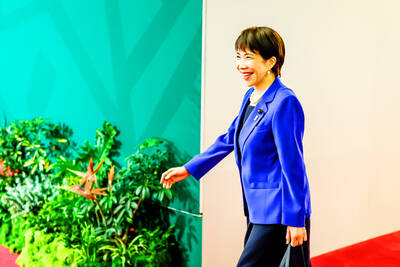For middle-aged Japanese men, it is never too late to be an action hero.
As the nation has fewer and fewer children, Japanese toy companies have found a vein of gold among grown-up kids, who are snapping up favorite childhood gadgets that are being upgraded and remarketed decades later.
Major toymaker Bandai recently launched ¥30,000 (US$270) adult-size reproductions of an action hero belt worn on the megahit Kamen Rider (masked rider) television series in the 1970s.

PHOTO: AFP
"When you grow up, you face lots of loathsome things in your workplace or at home," said Yasumasa Kawauchi, a Bandai official in charge of the boys' toys strategy.
Transformation
"Once you put this belt on, however, you can be Kamen Rider the hero, a different self," said the 39-year-old who himself grew up watching the show, in which the grasshopper-clad superhero battles a shady terrorist organization.
Kawauchi said it would give hard-working middle-aged men an opportunity to spend money on themselves by buying the leather belt, which flashes with LED lights.
As the former boys have acquired not only purchasing power but also girth, the belt stretches 110cm, about double the size of the original hot-selling version for children that first came out in 1971.
Bandai sold a staggering 3.8 million of the original Kamen Rider belts, enabling a generation of Japanese boys to shout out "Transform!" and spin their arms around to become cyborg heroes with blinking belts.
Salarymen on the streets of Tokyo show interest in the belt, even if not everyone is willing to spalsh out on one.
"This brings about strong flashbacks from my childhood," said 41-year-old Shoji Nishiguchi, who works for a wine import company.
"I have no plan to purchase it as ¥30,000 is a bit pricey. But I'm sure some people want it," he said. "It is great to see something you spent your childhood with appearing before you in an upgraded form."
A 39-year-old advertising agency official said: "I had one when I was little ... It's such sweet pleasure to see this again."
In the 1970s, each belt sold for ¥1,500, or ¥8,000 to ¥9,000 at today's prices. Kamen Rider still airs new episodes on Sundays and a new edition of the belt for children is on the market for ¥2,500.
Major toy store Hakuhinkan in central Tokyo said the adult belts have seen a fair share of interest, considering the high price, with many middle-aged men at least coming in to take a look.
Expanded market
"The boundary of toys has expanded. It is not unusual nowadays that adults buy toys for themselves," Hakuhinkan spokeswoman Harumi Ogikuma said.
In Japan, where men pack video arcades and there is nothing unusual about middle-aged women collecting dolls, adults provide an ideal market for the toy industry which is struggling to adjust to demographic trends.

LIMITS: While China increases military pressure on Taiwan and expands its use of cognitive warfare, it is unwilling to target tech supply chains, the report said US and Taiwan military officials have warned that the Chinese People’s Liberation Army (PLA) could implement a blockade within “a matter of hours” and need only “minimal conversion time” prior to an attack on Taiwan, a report released on Tuesday by the US Senate’s China Economic and Security Review Commission said. “While there is no indication that China is planning an imminent attack, the United States and its allies and partners can no longer assume that a Taiwan contingency is a distant possibility for which they would have ample time to prepare,” it said. The commission made the comments in its annual

DETERMINATION: Beijing’s actions toward Tokyo have drawn international attention, but would likely bolster regional coordination and defense networks, the report said Japanese Prime Minister Sanae Takaichi’s administration is likely to prioritize security reforms and deterrence in the face of recent “hybrid” threats from China, the National Security Bureau (NSB) said. The bureau made the assessment in a written report to the Legislative Yuan ahead of an oral report and questions-and-answers session at the legislature’s Foreign Affairs and National Defense Committee tomorrow. The key points of Japan’s security reforms would be to reinforce security cooperation with the US, including enhancing defense deployment in the first island chain, pushing forward the integrated command and operations of the Japan Self-Defense Forces and US Forces Japan, as

IN THE NATIONAL INTEREST: Deputy Minister of Foreign Affairs Francois Wu said the strengthening of military facilities would help to maintain security in the Taiwan Strait Japanese Minister of Defense Shinjiro Koizumi, visiting a military base close to Taiwan, said plans to deploy missiles to the post would move forward as tensions smolder between Tokyo and Beijing. “The deployment can help lower the chance of an armed attack on our country,” Koizumi told reporters on Sunday as he wrapped up his first trip to the base on the southern Japanese island of Yonaguni. “The view that it will heighten regional tensions is not accurate.” Former Japanese minister of defense Gen Nakatani in January said that Tokyo wanted to base Type 03 Chu-SAM missiles on Yonaguni, but little progress

NO CHANGES: A Japanese spokesperson said that Tokyo remains consistent and open for dialogue, while Beijing has canceled diplomatic engagements A Japanese official blasted China’s claims that Japanese Prime Minister Sanae Takaichi has altered Japan’s position on a Taiwan crisis as “entirely baseless,” calling for more dialogue to stop ties between Asia’s top economies from spiraling. China vowed to take resolute self-defense against Japan if it “dared to intervene militarily in the Taiwan Strait” in a letter delivered Friday to the UN. “I’m aware of this letter,” said Maki Kobayashi, a senior Japanese government spokeswoman. “The claim our country has altered its position is entirely baseless,” she said on the sidelines of the G20 summit in Johannesburg on Saturday. The Chinese Ministry